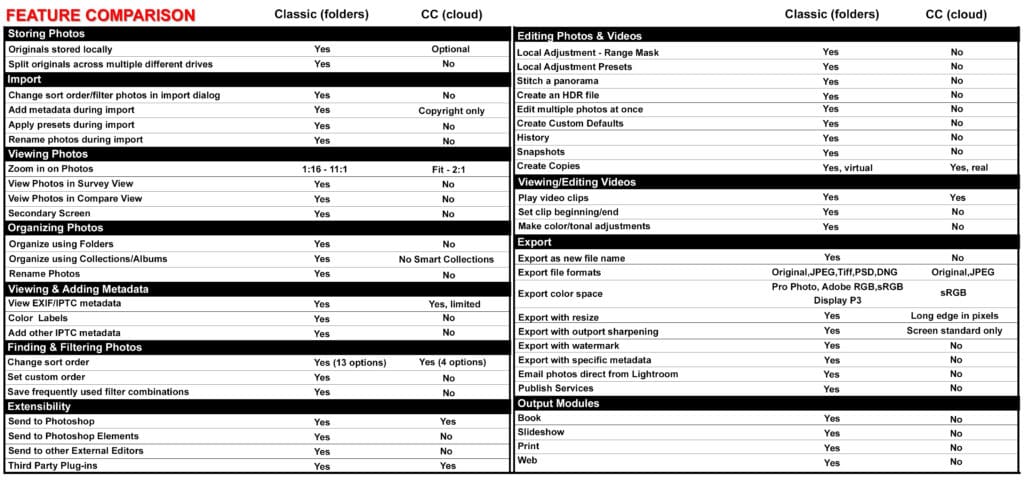

If you import images into Lightroom Classic CC, you still have the ability to sync images, but what gets sync’d are smart previews and not the original full resolution JPEG and Raw files. Lightroom Classic CCDidn’t Lightroom (Classic) CC have the ability to sync my photos and have them everywhere? Not completely.

This new desktop application now fits in the Lightroom CC family as a seamless way for photographers to have their images everywhere. Lightroom CC doing a search for “tree” and finding images that were never keyworded.OK then what is Lightroom CC? The existing version of Lightroom has been branded Lightroom Classic CC and there is a brand new built from the ground up application called Lightroom CC. The team has spent the last several months boosting the performance of Lightroom Classic CC, which is what we all wanted. It’s much faster in most areas than it was before. There is one change though besides the name. First off if you were already using Lightroom CC the good news is that Lightroom Classic CC is the same product that you’ve invested time in to learn and have been using for years. Let me try to clear up some confusion I’ve seen out there. Wait, wasn’t there already a Lightroom CC? Yes. It is the more powerful program of the two, but it’s not our favorite.Last week during Adobe MAX, Adobe took the wraps off its new photography system: Lightroom CC. If that’s no good to you, then you’re stuck with Lightroom Classic CC. To get the slick, streamlined experience of Lightroom CC you have to commit to Adobe’s web-based storage system. If only Lightroom Classic CC looked like this!Īnd there’s the rub. Its stripped down interface does lose many of the more in-depth options of Lightroom Classic CC, but it’s a much nicer and more efficient place to work. There’s a lot to like about Lightroom CC. If you need more, Adobe has told us this will cost an additional £9.98 / $9.98 / around AU$14 per terabyte, so if you have a big image library, this could get costly pretty fast. This will cost £19.97 / $19.99 / AU$28.59 per month, so effectively you’re paying £9.98 / $9.98 / AU$14.30 per month, or thereabouts, for 1TB storage. So this is where you might need the third option, which delivers Photoshop, both versions of Lightroom and 1TB storage – but at a price.
Adobe lightroom classic vs cc upgrade#
If you like Lightroom CC, however, you’ll need to upgrade your storage pretty sharpish. So it’s perfect if you want to carry on using Photoshop and Lightroom Classic CC, and it also lets you try out Lightroom CC and its online storage. This is the continuation of the regular Photography Plan, which includes both versions of Lightroom, and Photoshop, but only 20GB storage, for the same £9.98 / $9.99 / AU$14.29 per month price as the Lightroom CC Plan. First, this costs no more than the regular Photography Plan (below) BUT you don’t get Photoshop effectively, you swap Photoshop for your 1TB storage. This is new, and offers Lightroom CC with 1TB storage for £9.98 / $9.99 / AU$14.29 per month. Now that there are two versions of Lightroom, Adobe’s Photography Plan choices have become a little more complicated – there are now three, not one. If you use a lot of detailed filtering in Lightroom Classic CC you’ll be disappointed by the limited options here, but if you only use relatively simple filter options, like ratings or flags, you’ll probably appreciate the simplicity. You can still filter by rating, flag and file type (photo or video), but the metadata options are very basic and limited to Keywords, Cameras and Locations.

Lightroom CC strips these options right back. You can even save your filter presets for re-use another time. Filter items can include ratings, color labels, flags, whether a photo is an original or a virtual copy, and all kinds of metadata and shooting information, such as the camera used, lens, exposure settings and a whole lot more. One way of doing this is with a search, where you just type what you’re looking for into a search box and see what comes back.īut Lightroom Classic CC also has a very effective Filter Bar, where you can choose what you’re looking for from drop-down menus. Storing lots of photos is only part of the problem – you also need to be able to find the ones you want when you need them.


 0 kommentar(er)
0 kommentar(er)
